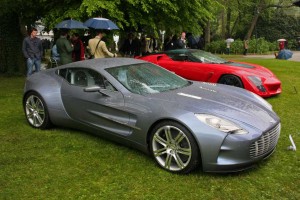
"50 are too few, 100 too many," so Aston plans to build 77 of its $1.8 million One-77 supercars.
Aston Martin has taken nearly a year to complete the slow striptease that has finally revealed its all-new supercar, the One-77.
At last year’s Paris Motor Show, visitors were greeted to a peek at the 2-seater’s fender. At the Geneva Motor Show, this past March, they got a look at a scale model. Despite an unseasonal downpour in “Sunny Italy,” the British maker pulled the wraps off entirely, driving up to the Concorso d’Eleganza, at the Villa d’Este, in a running prototype of the One-77.
Priced at a planned 1.2 million British pounds — $1.76 million at current exchange rates – Aston expects to build a grand total of 77 copies of the car, all next year.

You need the Aston Martin One-77's big haunches to handle the 750 hp output of its 7.0-liter V-12.
The long, low sports car bears a familial resemblance to the rest of the Aston line-up, including the current top-performer, the DBS, starting with the traditional Aston grille, Aston’s sliver door handles and the LED taillights seen as various DB models.
But on the whole, the One-77 has a more aggressive appearance, with wide rear haunches designed to house ceramic brakes and the oversized six-spoke wheels and tires needed to deliver all the new sports car’s power to the pavement.
According to chief designer Marek Reichman, the limited-production Aston will make a minimum of 750 horsepower once final numbers are certified. “We may get more,” he told TheDetroitBureau.com, during an interview at Villa d’Este, “but definitely not less than.”
The powertrain starts out with the same basic 6.0-liter V-12 block used by the rest of the Aston line-up, but it’s been significantly updated by British tuner Cosworth. In production form, it will here come in at 7.0-liters, and should be able to sprint from 0 to 60 mph in under 4.0 seconds, delivering a top speed of something over 200 mph.

There's room for two inside the Aston Martin One-77. It features a carbon fiber chassis and hand-hammered aluminum body panels.
Aston boasts of the One-77 as its “technology platform,” and that takes in everything from infotainment hardware to the unusual cooling system, with its large central and two smaller radiators. The air intakes for the latter automatically close off to improve high-speed aerodynamics. Cooling air is vented out through four chromed louvers, on the hood, as well as vents behind the front wheels. Brake heat is vented behind the wheels, as well.
The One-77 went through extensive aerodynamic work, said Reichman, noting that the side vents were designed to actually improve airflow along the supercar’s body. There’s a minimum of aero accessories, he pointed out, during a walk-around of the car. A small spoiler remains secured in the rear decklid until the One-77 reaches speeds of about 120 mph.
The car’s chassis, including its racing-style tub, is made of carbon fiber, which is also used for the roof. The rest of the body panels are hand-hammered aluminum. In all, the One-77 weighs in at just 1500 kg, or 3300 pounds. The body is just over 15 feet long, about four inches less than the DBS, while it stands about four inches lower.
“We very much wanted this to be a marriage of technology and art,” said Reichman. Asked why the odd production volume, he suggested that, “100 is too much, 50 too few. Seventy-five was too common.”
